Cozy season has arrived. Here’s how to make your own fall/winter escape in Charlotte.
November’s autumnal glow is a welcome sign of change in any normal year. This year, given the circumstances of the COVID-19 pandemic, that normally reassuring image of hunkering down by candlelight on a cold evening could be anything but.
A new and improved outdoor living space can assuage the thought of even more time at home over the next few months. What’s more, it could bring about joy and calm.
“With fall, we’re seeing how clients are trying to maximize their space outside,” said Michelle Lane, owner and principal designer with Modern Cottage, a design and home decor studio based out of Charlotte.
As we settle into both fall and the new reality of extended time inside, CharlotteFive asked several local designers and decor experts for tips on how to make an outdoor living space into a cozy fall retreat.
Bring the indoors outdoors
Your outdoor space shouldn’t be an afterthought, said Susan Hill, owner of Charlotte-based Susan Hill Interior Design, which offers interior and exterior design services. The personality and vibe of an interior space — and of its owner — should stretch beyond the house’s walls.
“Especially now with COVID, people really should supplement their interior space,” Hill said. “Just like with your interior space, where you have a living space and a dining space and other spaces, you want to apply those same principles as you go outside.”
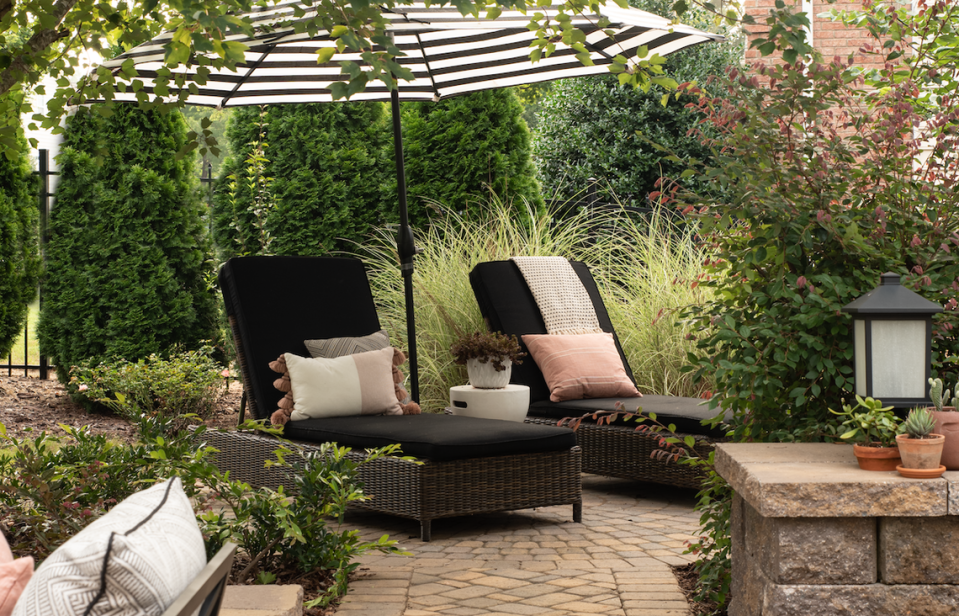
“Your outdoor space can be a continuation of your indoor space,” said Erika Green, owner of Charlotte-based Eye for Home Décor. “If you have a farmhouse look, you can apply that everywhere. If you have a glam touch, don’t be afraid to take it outside.
“It’s fun to add unexpected elements, especially in outdoor spaces like a patio or deck,” she said. “Bringing in something like a chandelier. … A faux cowhide rug. Bringing the indoors outside – you can have fun with it.”
You don’t need a full property to transform your space into a fall and winter haven. If you live in a smaller space, be creative and flexible with what you have.
“You can go into a smaller space with smaller pieces and still accommodate the bigger ideas,” Hill said. “For example, instead of putting in a 6-foot-long table, you can place a bistro table instead. Instead of putting in a sofa or chairs, you might put in a couple of club chairs or outdoors-style lounge chairs.”
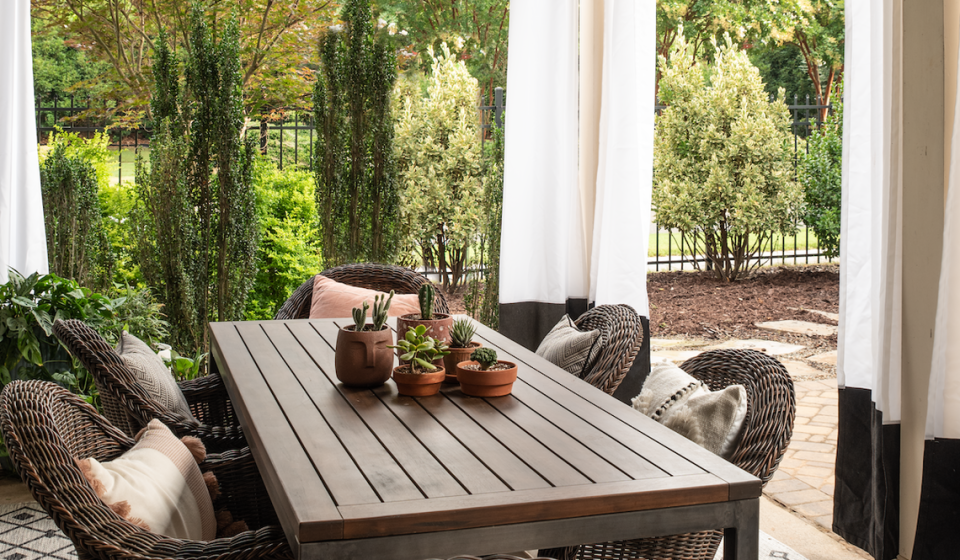
Add a spark — literally
Fire pits are a creative, cozy way to bring your outdoor space to a new level during autumn and winter.
“At this time of year, the most transformative items incorporate some sort of fire element,” said George Crump, design consultant with The Stone Man, an outdoor contractor based in the Charlotte area. “People are starting to think, ‘How can I get to enjoy these cooler evenings more?’ A fire pit is a more popular and logical option. It’s a social place. It’s casual, easy to use.”
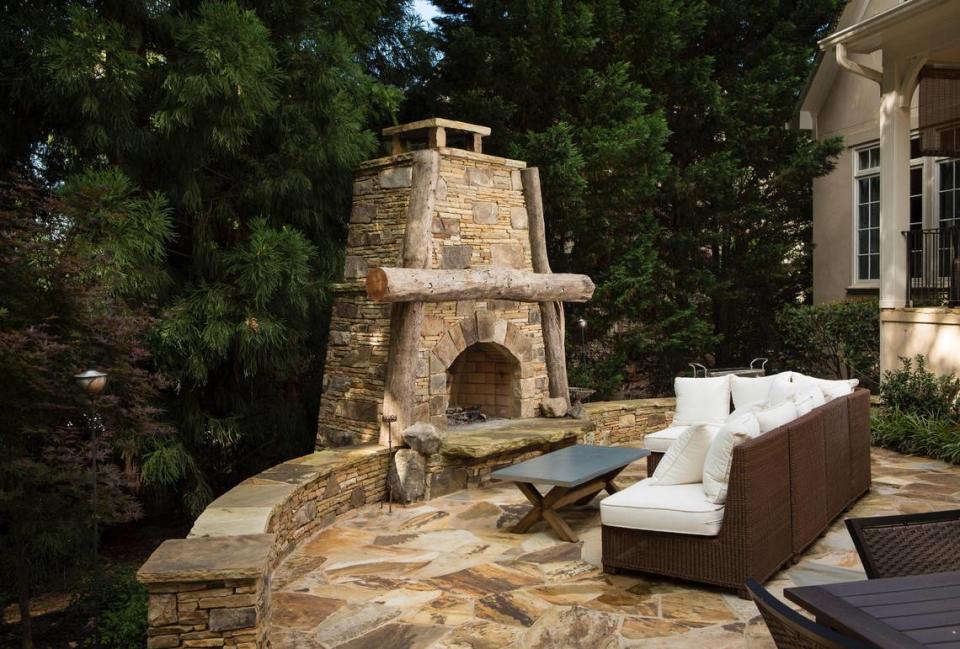
Options abound with fire pits, Crump said. If you’re interested in just testing it out, it’s perfectly fine to buy a nice portable fire pit from a store like Home Depot. For the intrepid, a fire pit patio, particularly when nestled into a hilly part of a property, is a great option. If you don’t like the smoke from a traditional fire pit, opt for a gas fire.
And even if a full-on fire pit isn’t for you, it’s possible to still create the same feeling, Modern Cottage’s Lane said. Instead, you can easily put a coffee table in your yard and add group seating and lighting around it.
Power up your space
No matter how simple or jazzed-up your outdoor oasis is, it’s important to remember the technical side of things: lighting, outlets, extension lines. After all, that autumnal incandescent glow won’t exist without electricity, so we asked Bobby Lynn, owner of LiveWire Electrical, for some help LiveWire is a residential electrical company serving Charlotte and surrounding areas.
First, you need to account for power outlets – and know the rules, he said. You’ll also need to make sure your design drawings line up with your property’s existing development plans.
When it comes to lighting itself, be sure to follow IECC guidelines and consider implementing LED lights to save on money and energy. The main takeaway is to plan ahead, Lynn said.
“Electrical systems require some forethought before committing to wiring plans and breaker boxes,” he said. (We’ll include more of Lynn’s technical tips at the bottom of this article.)
Use nature as your guide
Just as you can bring the indoors outside, you can do the opposite and bring the outdoors in.
Don’t be afraid to take advantage of nature’s bounty itself during this time. Fresh flowers are an easy and cheap way to freshen up your living space, especially in fall, said Jameka Whitten, owner of Charlotte-based home decor brand Lavondé’s Light.
“I get fresh flowers every week for my home,” Whitten said. “Try a seasonal bouquet — right now is the time to get those nice fall colors. And it’s fairly inexpensive. You can go to the local grocery stores and pick up $4 bouquets.”
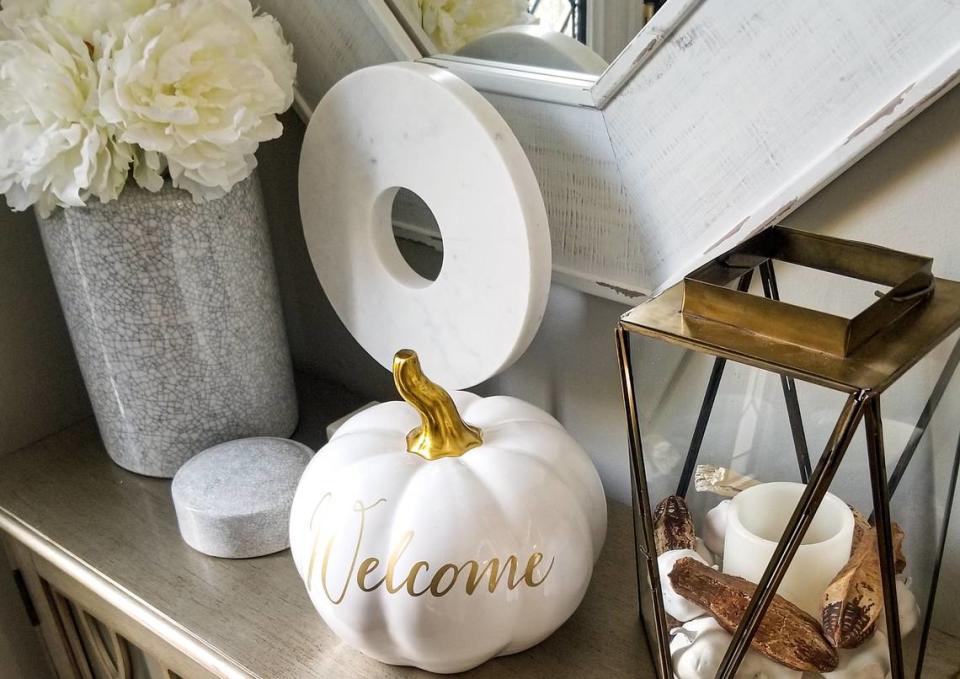
You might even be able to find something in your own backyard. Lane recommends “branching,” or using clippings from the outdoors in your decor. Grab a pair of garden scissors, head outside and clip away (but be sure to respect local rules and private spaces if you explore past your yard). Pair your newly found natural bounty with a simple clear vase, and you’ve got an instant autumnal vibe.
“Using branches in a vase looks nice and sculptural,” said Ariene Bethea, shop owner and “chief huntress” with Dressing Rooms Interiors Studio in Charlotte. “You’re literally bringing nature inside. It’s easy, and looks great.”

Plus, embracing natural materials is not only beautiful but can prevent waste, said Sonal Gurjar, owner of Charlotte-based textile company ShreeRoopam. It’s important to “be more mindful with our fall decoration and invest in sustainable pieces.”
Displaying branches and other natural treasures is just one of the small ways to bring the season into your space. Cozy candles and calming scents are made for this time of year. And layers aren’t relegated to the closet anymore.
“One of the first things I usually ask people is if they have a fur throw,” Bethea said. “I use mine all year long; some people bring that out in the fall and winter.”
Add some richly-colored pillows to your seating arrangement for an instant autumnal touch. If you have several rugs, consider layering them for an even cozier feel. Add a couple of candles, replace a couple light bulbs with dimmable bulbs, et voilà – your escape awaits.
“I’m big on essential oils, which is obvious with my candles,” Whitten said. “I have diffusers all over the house. Scents are very seasonal. You can have pumpkin smells, whatever you like. … You can even make your own essential oils. Find a recipe online, and put your ingredients right in your crockpot.”
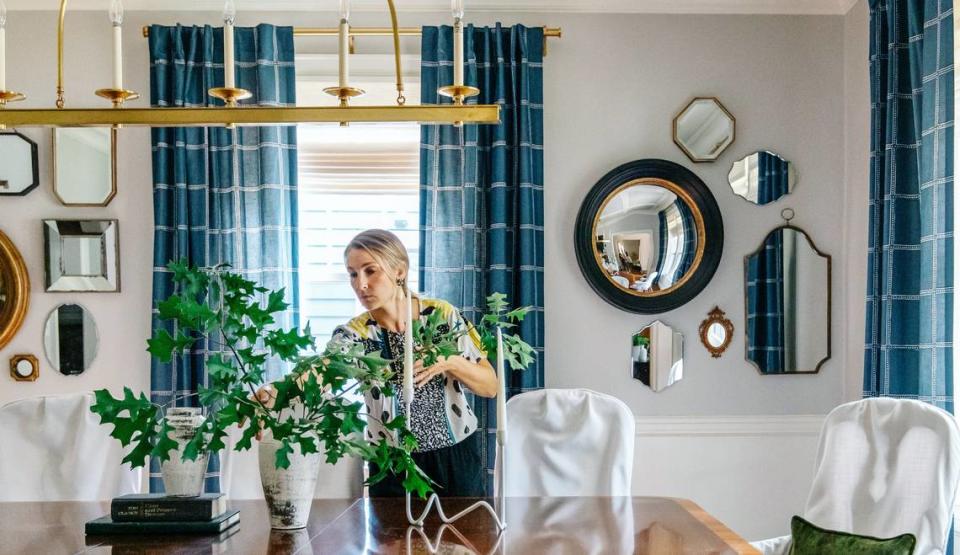
During fall, all you need to do is create a feeling of warmth in the space, Lane said. Add some pillows, blankets — maybe even a s’mores kit — and you’re well on your way to creating a fall escape, inside or out.
Try on a look for size
Local experts emphasized that experimentation and flexibility is key to decorating for the seasons — and any time.
“Let’s say you have a patio and decide to move things around,” Crump said. “Get a nice metal fire pit to see if you want it. Try it out. If you like it, then look for something more permanent.”
You can even choose one specific seasonal spot where you update the look as the seasons change, Bethea said. Swap out plants on your porch every season or display a nice bowl with rotating harvest food items on your entryway table.
Decor will come and go, just like the seasons. By setting yourself up for success with a mind for personality, creativity and flexibility, you’ll be able to weather any decor change — no matter the time of year.
Get our newsletter
Sign up now to get CharlotteFive in your inbox daily.
If you’re ready to dive into the technical aspect of planning your backyard space, LiveWire’s Lynn wrote 5 electrical factors you should know before planning your outdoor living space in Charlotte. Warning, it gets into the weeds, but if you’re ready to dive in, here you go:
5 electrical things you should consider before planning your outdoor living space
(1) Power outlets
Before planning for the exciting and fun items such as outdoor appliances and pools, you need to account for power outlets. In general, these regulations apply to outdoor power outlets:
If a receptacle is being used to power a pump system in a pool, hot tub or spa, it needs to be located no closer than 10 feet away from the interior wall of the structure if the outlet is not GFCI protected, and no closer than 6 feet if it is GFCI compliant.
A permanent swimming pool is required to access a GFCI-compliant receptacle between 6 and 20 feet from the edge of the pool. The receptacle cannot be higher than 6.5 feet above the pool deck.
Receptacles should have a weatherproof cover, including those that are in semi-covered locations such as under a porch roof.
Decks and balconies are required to have a receptacle no more than 6.5 feet above the gallery or deck’s walking surface. Houses are also recommended to have at least one receptacle available for outdoor use at the front and rear of the building.
All outdoor circuits require GFCI protection.
Planning and installing power outlets shouldn’t be attempted without the supervision of an electrician because too many things can go wrong.
(2) Utilities and appliances
Many homeowners who invest in an outdoor living space underestimate the necessity of planning for utilities and appliances in advance. Several homeowners simply consider appliances as a bridge they’ll cross when they come to it. Unfortunately, in many cases, the lack of planning makes it difficult, if not impossible, to add support for appliances after the installation of utilities is already done.
Planning for your utilities means ensuring that your design drawings line up with the existing development plans. You should double-check to ensure that your electrical circuits line up with the appliances you intend to install in the future. Running extension lines after your initial installation can be costly and require ripping up your outdoor kitchen to allow for wires.
In the same sense, you don’t want to be removing your turf or flooring tiles after they’ve been put down. To avoid having to do this, you should take a look at your electrical, water and gas supply lines and ensure they are installed and working correctly before putting down tiles, turf or concrete flooring options.
(3) Lighting
When planning lighting for your outdoor space, be sure to follow IECC guidelines and consider implementing LED lights to save on money and energy.
The IECC advises that homeowners follow specific suggestions on outdoor lighting. At least one lighting outlet is required at grade level for any exterior-facing door, except for vehicle garage doors. If you’re using a transformer for your low-voltage electricals, it must remain accessible. Outdoor lighting fixtures and lights in damp areas must be listed as existing in wet locations. Cables that pass through wet areas or underground need to be underground feeder (UF-B) type cables.
When it comes to selecting the actual lighting systems, you should consider LED lights. LED lighting ranks as one of the best ways to light an outdoor space and with good reason. LEDs offer customizability through their coloration, but they also give homeowners a slew of other benefits. LEDs don’t burn out as often as incandescent lights, which means fewer bulb changes and less waste. Production of LEDs is carbon-efficient, and they use a lot less energy than standard incandescent or fluorescent bulbs. They also run a lot cooler, keeping the hazard of burns to a minimum.
(4) Swimming pools
Swimming pool installation as part of an outdoor living space can change the entire dynamic into one that’s a lot more fun. What you may not have realized is that pool installations carry a handful of critical electrical considerations.
Keep in mind these important notes about underground wiring:
If you have to run underground lines, they cannot come closer than 5 feet from the pool’s edge.
If you have limited space to work with, installing a conduit system may be necessary and give you some leeway in how close you could run your wires to the edge of the pool.
Ideally, concrete encasement should be used. Conduits that pass close to the pool should be sealed or encased in concrete for added protection.
For overhead lines, remember:
Wiring above the pool should be no less than 22.5 feet above the water’s highest level.
Communications cables (cable TV, telephones, etc.) should be no less than 10 feet above the water’s highest surface level.
If you’ll be using long pool-cleaning equipment, being aware of these wires’ locations can help prevent electrical shock.
(5) Outdoor speakers
What’s an outdoor living area without a sound system? Whether you want to be able to enjoy your country music while you lounge by the pool or play the hits at your backyard barbecue, you’ll benefit from installing outdoor speakers.
Outdoor speakers usually work using a control panel that’s installed indoors. Running the connection may consider some forethought. The volume control box will be installed outside the house and should be kept in a safe, sheltered location so that it doesn’t get wet or exposed to the elements. Speaker wires should be run through holes drilled into the wall. It’s not recommended to pass them through windows or doors, as these cables can create hazards or become broken when the openings close. Alternatively, you could use Bluetooth or wireless speakers and do away with the cables completely.
Bobby Lynn, owner of LiveWire Electrical, contributed to this article, writing the last section about electrical considerations.

